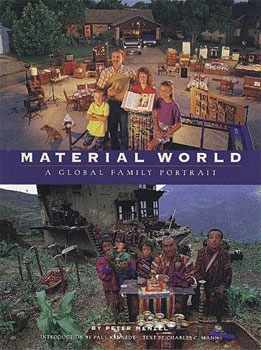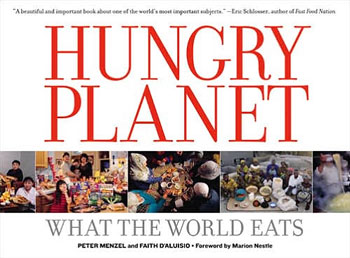| book recommendations

Material World:
A Global Family Portrait
by Peter Menzel
This remarkable book has been around for a while. From Amazon:
|
A fascinating look at the material possessions of families throughout the world. These people have been determined "average" for their countries and have agreed to have photographers move the contents of their houses outside in order to create visible representations of their relative standards of living. The dirt house and few possessions of Mali residents contrast with the 4 cars, 45-foot long sofa, and 12+ oriental carpets lined up outside the luxury home of a family from Kuwait. Each chapter includes the original spread of possessions, statistics about each family and country, as well as further pictures of daily life and some observations by the photographer. Interspersed among the chapters, which are divided by region, are pictorial representations of such interesting comparisons as televisions, meals, and toilets. Almost all of the pictures are in full color. Menzel hoped this would be "a unique tool for grasping cross-cultural realities." It is that and much more.
| |
Taking portraits with the subject's material possesions isn't really new. It's just that he uses this portrait technique to illustrate cultural differences so effectively. It was done in 1994 and there have been a lot of changes in the world in that time. When I finished the book I was wishing for an update. When I checked Amazon for information about Material World I discovered he did have an update of sorts:

Hungry Planet:
What the World Eats
by Peter Menzel, Faith D'Aluisio
From amazon:
|
For their enormously successful Material World, photojournalist Menzel and writer D'Aluisio traveled the world photographing average people's worldly possessions. In 2000, they began research for this book on the world's eating habits, visiting some 30 families in 24 countries. Each family was asked to purchase—at the authors' expense—a typical week's groceries, which were artfully arrayed—whether sacks of grain and potatoes and overripe bananas, or rows of packaged cereals, sodas and take-out pizzas—for a full-page family portrait. This is followed by a detailed listing of the goods, broken down by food groups and expenditures, then a more general discussion of how the food is raised and used, illustrated with a variety of photos and a family recipe. A sidebar of facts relevant to each country's eating habits (e.g., the cost of Big Macs, average cigarette use, obesity rates) invites armchair theorizing. While the photos are extraordinary—fine enough for a stand-alone volume—it's the questions these photos ask that make this volume so gripping. After considering the Darfur mother with five children living on $1.44 a week in a refugee camp in Chad, then the German family of four spending $494.19, and a host of families in between, we may think about food in a whole new light. This is a beautiful, quietly provocative volume.
| |
|

